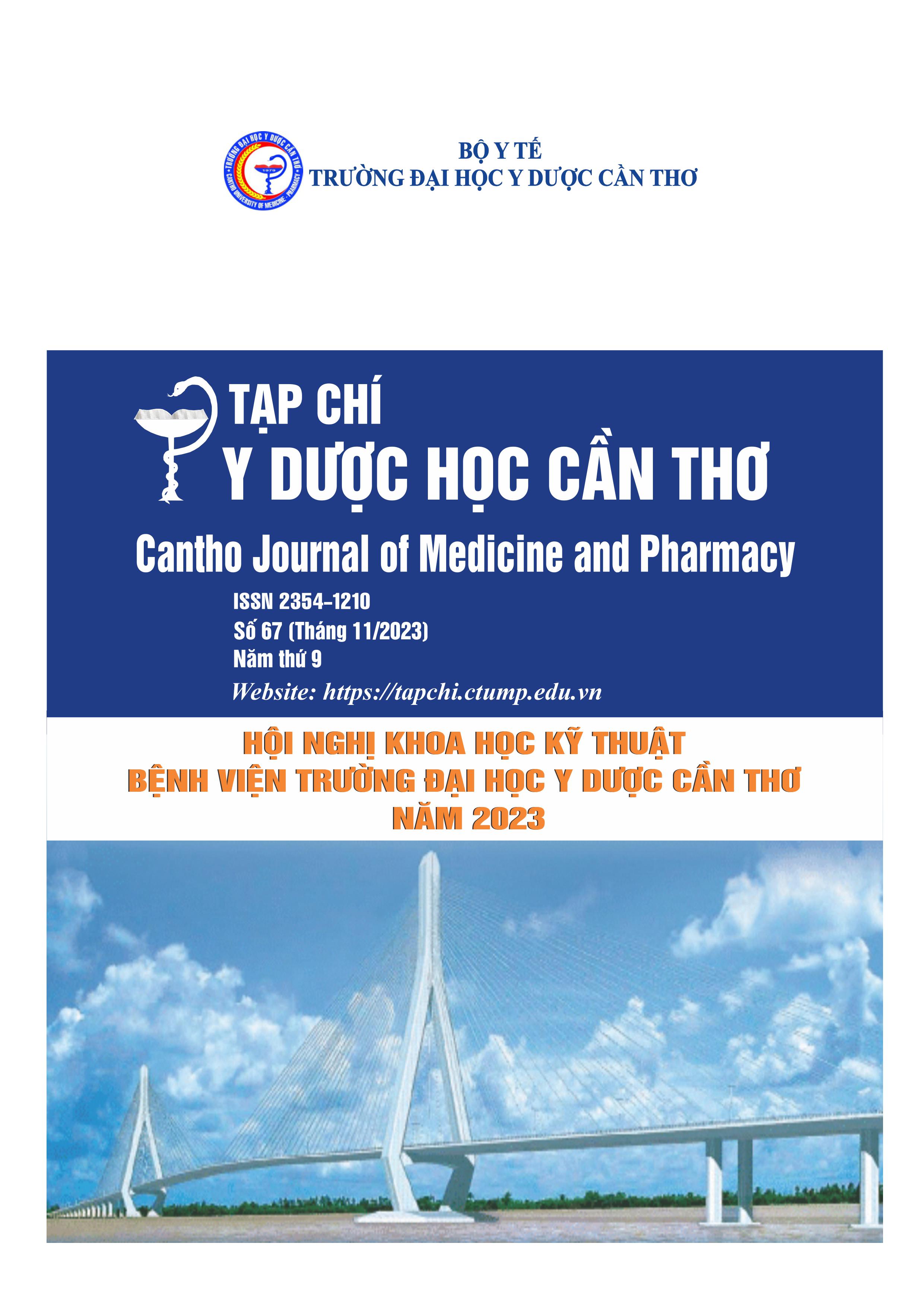THE RESULTS OF PERCUTANEOUS NEPHROLITHOTRIPSY UNDER THE GUIDANCE OF THE C-ARM AND ULTRASOUND
Main Article Content
Abstract
Background: Kidney stones are a common disease that can have a significant impact on one's health and society. It is also a disease with a recurrence risk of above 50%. Mini-percutaneous nephrolithotomy surgery is widely applied and gradually replacing classic open surgery in the treatment of kidney stones. Objective: To evaluate the results of the safety and effectiveness of kidney stone treatment using mini-percutaneous lithotripsy under the guidance of C-arm and ultrasound at Can Tho University of Medicine and Pharmacy Hospital. Materials and methods: A cross- sectional description study on 48 patients with kidney stones ≥ 20mm in size at Can Tho University of Medicine and Pharmacy Hospital from November 2022 to September 2023. Results: There were 48 kidney stone cases treated with mini-percutaneous nephrolithotomy, with 28 males and 20 women with an average age of 52.8 (30– 80). The average stone size was 29.6 mm. The rate of puncture into the lower calyx was 54.2%, and the middle calyx was 45.8%. The average surgery time was 72.4 minutes. No complications were recorded during the surgery. 05 cases of postoperative complications (10.4%). The average hospital stay was 8.5 days. The rate of stone clearance early after surgery was 70.1%. Conclusion: Mini-percutaneous nephrolithotomy in the flank position under the guidance of the C-arm and ultrasound is a surgical method that ensures safety and effectiveness in treating kidney stones.
Article Details
Keywords
Kidney stones, percutaneous nephrolithotomy, mini-PCNL
References
2. Raney. A.M. Electrohydraulic lithotripsy: experimental study and case reports with the stone disintegrator. J Urol. 1995; 113 (3): 345- 347. DOI: 10.1016/s0022-5347(17)59477-x.
3. Segura. J. W. Percutaneous removal of kidney stones: review of 1000 cases. J. Urol. 1985; 134: 1077-1081. DOI: 10.1016/s0022-5347(17)47633-6.
4. Valdivia Uría JG, Valle Gerhold J, López López JA et al. Technique and complications of percutaneous nephroscopy: Experience with 557 patients in the supine position. J Urol. 1998; 160: 1975–8. DOI: 10.1016/s0022-5347(01)62217-1.
5. Kerbl K, Clayman RV, Chandhoke PS, Urban DA, De Leo BC, Carbone JM. 1994. Percutaneous stone removal with the patient in a flank position. J Urol; 151: 686 – 84. DOI: 10.1016/s00225347(17)35048-6.
6. Hossein Karami, Reza Mohammadi, Behzad Lotfi. A study on comparative outcomes of percutaneous nephrolithotomy in prone, supine, and flank positions, World Journal of Urology. 2012. 31, 1225–1230. DOI: 10.1007/s00345-012-0889-y.
7. Qinglong Chi, Yan Wang, Ji Lu, Xiaoqing Wang, Yuanyuan Hao, Zhihua Lu. Ultrasonography Combined with Fluoroscopy for Percutaneous Nephrolithotomy: An Analysis Based on Seven Years Single Center Experiences, Urol J . 2014. 11(1):1216-21. PMID: 24595927. 8. Hoàng Long, Trần Quốc Hòa, Chu Văn Lâm, Nguyễn Thị Hằng Trang và Nguyễn Đình Bắc. Kết quả tán sỏi qua da qua đường hầm nhỏ tư thế nằm nghiêng dưới hướng dẫn của siêu âm, Tạp chí nghiên cứu y học. 2020. 134 (10), 109-15.
9. Dương Văn Trung. Kết quả tán sỏi thận qua da đường hầm nhỏ tư thế bệnh nhân nằm nghiêng tại Bệnh viện Bưu điện, Y Học TP. Hồ Chí Minh. 2018. 22 (4), 105-9.
10. Nguyễn Việt Cường, Trần Hoài Nam, Nguyễn Văn Khẩn, Phạm Đức Vinh. Đánh giá kết quả phẫu thuật lấy sỏi thận qua da đường hầm nhỏ tại Bệnh viện Quân y 175, Y Học TP. Hồ Chí Minh, Phụ Bản. 2019. 23 (3), 53-9.
11. Huỳnh Nguyễn Trường Vinh, Nguyễn Vĩnh Bình, Phan Đức Hữu, Cao Vĩnh Duy. Đánh giá kết quả sớm điều trị sỏi thận bằng phẫu thuật tán sỏi qua da đường hầm nhỏ tại Bệnh viện Xuyên Á
2021-2022, Tạp chí Y Dược Học Cần Thơ. 2022. 55, chuyên đề Hội Nghị Quốc tế, 123-30. https://doi.org/10.58490/ctump.2022i55.390.
12. Yang L, Jad A, Wei Z, et al. Comparison of supermini PCNL (SMP) versus Miniperc for stones larger than 2 cm: a propensity scorematching study. World Journal of Urology. 2018; 36 (6): 955-961. DOI: 10.1007/s00345-018-2197-7.
13. Liu L, Zheng S, Xu Y, et al. Systematic review, and meta-analysis of percutaneous nephrolithotomy for patients in the supine versus prone position. J Endourol. 2010; 24: 1941– 6. DOI: 10.1089/end.2010.0292.


